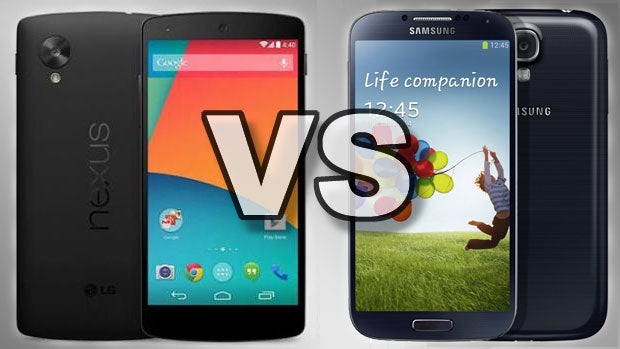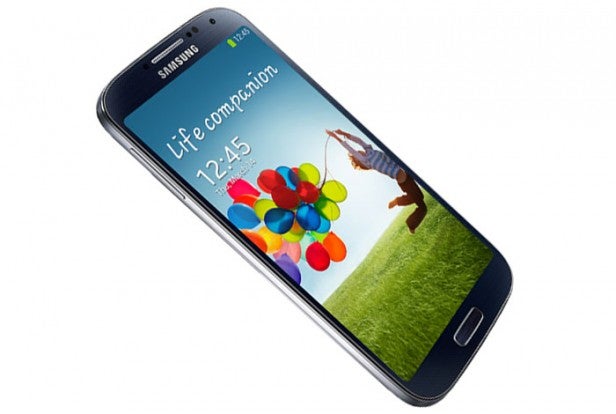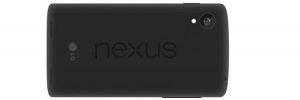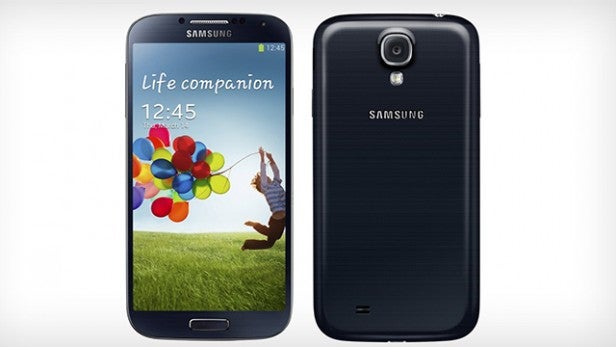Nexus 5 vs Samsung Galaxy S4: Which Android phone to buy?

Samsung Galaxy S4 or Nexus 5? Both are still great Android phones and are now much cheaper to own now. We compare the specs
The Samsung Galaxy S4 was the best-selling high-end Android phone of 2013 and since been updated through the Galaxy S5 and the Galaxy S6.
One of its top rivals is the Google Nexus 5,
a phone made by LG. It costs just £299, but is it really the best
Android around, as some claim? Let’s see how it stacks up against the
Galaxy S4.
Nexus 5 vs Samsung Galaxy S4 – Price and Deals
Nexus 5 – From £299 SIM-free
Galaxy S4 – From £385 SIM-free
The
Galaxy S4 price has come down a good deal since the phone launched in
early 2013 – from £600 to around £380. However, it’s still a fair bit
more expensive than the Nexus 5.
The Nexus 5 starts at £299 direct from Google. That gets you the 16GB edition, while the 32GB version costs £339.
There
are multiple versions of the Galaxy S4, maxing out at 64GB of storage.
However, by far the most common version in the UK is the 16GB edition. That’s the version you can get for a shade under £400.
If you want so save some money, the Nexus 5 is the way to go.
SEE ALSO: Samsung Galaxy S4 vs S5 vs S6
Nexus 5 vs Samsung Galaxy S4 – Design
Nexus 5 – Matt black plastic, 8.6mm, 130g
Galaxy S4 – glossy plastic, 7.9mm, 130g
The
Nexus 5 and Galaxy S4 have quite different approaches to design, but
both are made of plastic. The Nexus 5 has a simpler, matt black design
while the Galaxy S4 uses glossy plastic. In our opinion, the Nexus 5
feels better in the hand.
These phones weigh the same amount –
130g. That’s very light for a phone of this size. The Galaxy S4 is the
slimmer of the two, at an impressive 7.6mm thick, but the Nexus 5 isn’t
chunky enough to make this a particularly serious consideration.
However,
the Galaxy S4 does have one significant design benefit. It has a
microSD memory card slot that lives under the battery cover. The Nexus
5’s back is non-removable, but this helps to give it a more solid feel
than the Galaxy S4.
Nexus 5 vs Samsung Galaxy S4 – Screen
Nexus 5 – 1080p 5-inch IPS screen
Galaxy S4 – 1080p 5-inch Super AMOLED
The
screens of these two phones are fairly evenly matched. They are both
five inches across (4.95 inches and 4.99 inches to be exact) and have
1080p resolution panels.
Their screen types are completely
different, though. The Nexus 5 has an IPS-type screen and the Galaxy S4 a
Super AMOLED screen.
The key difference is that IPS screens use
a standard backlight where AMOLEDs use light-emitting pixels, helping
to provide much better contrast than an IPS screen can hope to. However,
this only really becomes apparent when looking at the phone’s screen in
a pitch black room. The Nexus 5 still offers very good contrast, even
in dimly-lit rooms.
The Nexus 5 fights back with sharpness. As
the Galaxy S4 uses an irregular sub-pixel array (a diamond shaped
PenTile layout), sharpness isn’t quite as good as the Nexus. However, as
with contrast, you simply won’t notice the difference in everyday use.
Both screens are extremely sharp.
One minor pitfall of the
Galaxy S4 screen is that it lets you oversaturate the colours – a common issue
with AMOLED-type screens. However, make sure the phone is on the right
screen setting in the phone’s menu and image quality is top notch.

Nexus 5 vs Samsung Galaxy S4 – Software and Interface
Nexus 5 – Android 4.4
Galaxy S4 – Android 4.3 with TouchWiz
The
Nexus 5 and Galaxy S4 are polar opposites in terms of their approach to
Android. The Nexus 5 uses completely vanilla Android 4.4 KitKat while
the Galaxy S4 has a heavily customised version of Android 4.3.
Samsung
generally refers to it as the ‘Samsung UI’ these days, but it’s
better-known as TouchWiz. It adds a load of features, such as Smart
Stay, which keeps the screen active when the front camera senses your
eyes looking at the display. Yep, many of Samsung’s additions are a bit
gimmicky. And it doesn’t look anywhere near as good as the redesigned
interface of Android 4.4 KitKat.
Neither phone suffers from any
particularly significant lag, though. TouchWiz is a fairly bloated
interface, though, which can cause some slight slow-down when you have a
bunch of apps installed.
The Nexus 5’s vanilla Android 4.4 has
fewer features, but still has enough to satisfy most people. It also
features pre-installed Quickoffice, the Google Android alternative to
Microsoft Office. The Galaxy S4 comes with Polaris Office pre-installed.
It’s a third-party alternative. And Quickoffice is available for free
from Google Play anyway, if you don’t get on with Polaris.
Nexus 5 vs Samsung Galaxy S4 – Power – CPU, GPU and RAM
Nexus 5 – Snapdragon 800 quad-core 2.3GHz CPU, 2GB RAM, Adreno 330 GPU
Galaxy S4 – Snapdragon 600 quad-core 1.9GHz CPU, 2GB RAM, Adreno 320 GPU
The
six months between the releases of the Galaxy S4 and Nexus 5 shows up in
their specs. Where the Galaxy S4 uses a Snapdragon 600 processor, the
Nexus 5 has a newer Snapdragon 800 chip.
Its clock speed is
significantly higher – 2.3GHz to the Galaxy S4’s 1.9GHz, and the chip is
significantly faster all-round. Of course, this difference is largely academic as
any slow-down in the Samsung phone is a result of software optimisation issues
rather than a lack of raw power. They’re both fast chips.
Both phones have 2GB of RAM, which is enough to keep them running well with plenty of apps installed.
Benchmarks
such as AnTuTu, Kraken and 3DMark all show that the Nexus 5 is
significantly more powerful than the Galaxy S4, and is closer to the
performance of the newer Galaxy Note 3.
Nexus 5 vs Galaxy S4 – Storage
Nexus 5 – 16/32GB internal storage, non-expandable
Galaxy S4 – 16GB,32GB and 64GB with microSD card slot
If
it sounds like we’re not picking enough of a clear winner in some
categories, storage makes it easy to pick one clear winner – it’s the
Galaxy S4. It has a microSD memory card slot under its battery cover,
letting you bump up the internal memory for just a few quid.
We
do think some people obsess a little too much over the idea of
expandable memory, but it is very handy if you want to use your phone as
a portable video player.
Both phones have at least 16GB of
internal memory, but there are higher-end models available too. There’s a
32GB edition of the Nexus 5, and both 32GB and 64GB versions of the
Galaxy S4. The higher-capacity versions aren’t readily available,
though. The 64GB version in particular is very hard to get hold of in the
UK.
SEE ALSO: Samsung Galaxy S6 vs iPhone 6
Nexus 5 vs Samsung Galaxy S4 – Camera
Nexus 5 – 8-megapixel sensor with LED flash, 1.3MP front camera
Galaxy S4 – 13-megapixel sensor with LED flash, 2MP front camera
One
aspect of the Nexus 5 that feels like a bit of a cutback is the camera.
It has an 8-megapixel camera – not too bad – but it’s an infuriatingly
slow snapper at times. You can take great shots with the thing, but you
need patience. It’s pretty unreliable too, suffering from issues with
white balance and exposure. Its saving grace is a rather good HDR mode,
although this too needs some patience as it’s not super-fast.
The Galaxy S4 camera is more reliable, higher-res and quicker. It also has oodles of features, in traditional Samsung style.
There’s
one killer extra in the Nexus 5 – optical image stabilisation. This
gives the Nexus better low-light performance than the Samsung phone, and
many other rivals too.
Neither camera is particularly high-end,
though. They both use 1/3.2-inch sensors – the normal size for a phone –
and unremarkable lenses. The Galaxy S4 has an f/2.4 lens and the Nexus 5
a fairly slow f/2.5 lens.
Fingers crossed Google or LG (the
phone’s maker) will sort out some of the Nexus 5’s issues in an update.
But for now the Galaxy S4 is a better all-rounder.
Verdict
Despite
the Galaxy S4 price drop, the Nexus 5 is still significantly cheaper
than the Galaxy S4. And given you get a comparable screen, faster
processor, prettier software and – in our opinion – a slightly more
appealing design. It’s the better-value option.


